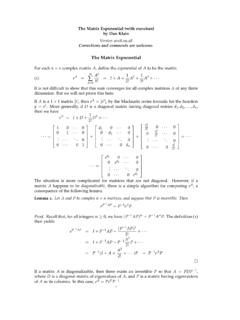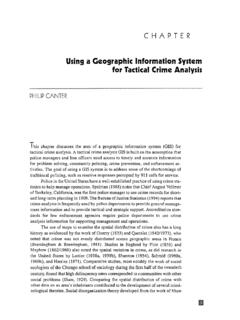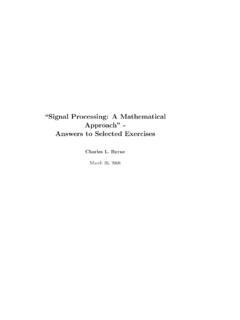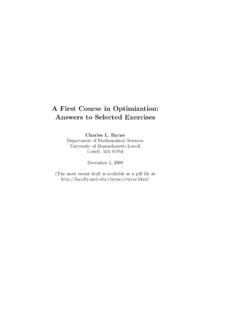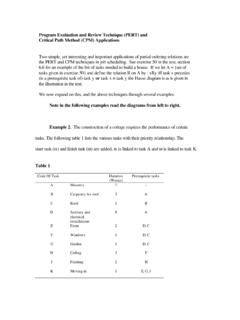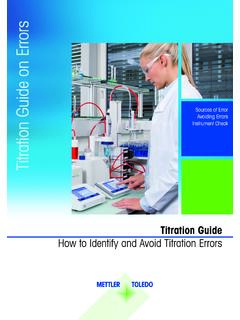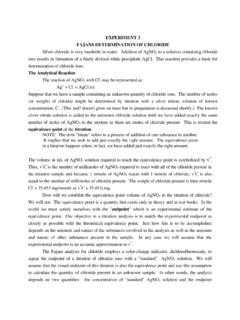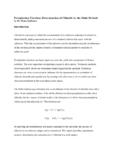Transcription of 84.315 Analytical Chemistry I Laboratory Manual
1 1 University*of*Massachusetts*Lowell*Depar tment*of* Chemistry * Analytical * Chemistry * Laboratory *I* Fall*Semester* Instructor:*Dr.*David*K.*Ryan* 2 List*of*Experiments* ACID%BASE) titrations ) 1 Preparation and standardization of M NaOH and M HCl solutions using a primary standard KHP and phenolphthalein indicator 2 Determination of equivalence point using pH titrations of KHP and M NaOH with phenolphthalein indicator 3 Determination of acid content in vinegar by volumetric and potentiometric titration 4 Direct versus back titration for the determination of vitamin C in tablets 5 Evaluation of an antacid by volumetric titration COMPEXATION) titrations ) 6 a) Determination of Ca by displacement titration b) Determination of Ca by back titration c) Direct titration for the determination of Mg in a sample d) Determination of water hardness 7 Evaluation of commercial dried milk powder by complexation titration precipitation )REACTIONS) 8 a) precipitation titration: Determination of percentage Cl- by Mohr's method.
2 B) Determination of percentage of Cl- in an unknown by gravimetric method REDOX)TITRATION) 9 a) Preparation and standardization of KMnO4 b) Determination of iron in its ore 3 Introduction* General)information)Each week, before the experiment starts, we will meet in the Analytical Laboratory , Olney 309. Prior to arriving at lab, a brief instructional video describing the experimental concepts, the procedures and safety considerations will be viewed. We will prepare all the solutions needed in this lab and conduct most of the experiments there as well. Some experiments may be conducted where the instruments are located and may be performed in groups. The experiments are designed to take no longer than 4 hours each, if you are properly prepared. Laboratory )Safety)Rules) Even though every wet chemical Analytical experiment to be carried out in the lab has been tested many, many times before and every procedure is known in detail, Laboratory safety cannot be overlooked.
3 Accidents do happen from time to time. In order to protect you, your classmates, and the university property, the following rules will be enforced at all times. 1. Be acquainted with the location and use of facilities and familiar with safety precautions and procedures. 2. Students must wear adequate eye protection at all times. Contact lenses are never permitted to be worn in the Laboratory as vapors can collect under the lenses. 3. Be familiar with the method of operation and all potential hazards involved before engaging in any lab work. Know the properties, such as flammability, reactivity, corrosiveness, toxicity, etc., of the chemicals you are using. 4. Responsible behavior is required at all times. 5. No eating, drinking, or smoking in the Laboratory . 6. Proper clothing (coverage from the shoulders to the knees) must be worn in the Laboratory . No sandals or open-toed shoes are permitted. 7. Do not fill pipettes by mouth suction.
4 8. Do not use glassware that has been chipped or broken. 9. Dispose of chemicals according to an approved procedure. Do not dump them down the sink. 10. Report all accidents including minor injuries to your instructor. 11. Clean everything you used and wash your hands thoroughly before leaving the Laboratory . 4 Lab)reports))Reports are due one week after completion of the experiment and should be handed in at the beginning of the lab period. Though experiments are sometimes performed in groups, lab reports and unknowns are to be done on an individual basis. Lab reports should be prepared using a word processor using " x 11" paper and pages should be numbered. The format should be similar to a journal article (see Analytical Chemistry ) with some differences in emphasis due to the nature of the course. More instrumental details than one normally finds in journal articles should be included in lab reports. The general format includes the following sections: Title Page - including the title of the experiment, your name, and the date on which the experiment were performed.
5 Abstract - summarizing the work done and reporting major results, including numerical results, instrumental technique used, instrument used, and the result of the analysis of the unknown. This is not an introduction or purpose. The abstract is very important and should only be written after your results have been evaluated completely. Introduction - describing the basis for the experiment. In general, present the theory behind the technique utilized. Keep your theory pertinent to the actual measurements taken, use your own words, and use references where appropriate. Also a block diagram of the instrument to be used should be presented. Cite your source for this diagram correctly and a description of its components and how it works. Experimental - brief outline of procedure noting where different from the lab Manual . Write in past tense and in complete sentences. Follow examples shown in the journal Analytical Chemistry .
6 You do not need a great deal of information here; especially avoid presenting step-by-step instructions or directions. Describe equipment used including manufacturer and model, preparation of solutions, etc. Less than one page will almost always be sufficient. Results - including tables of data, graphs or figures, and data analysis . A description of the data presented in tables, figures and calculations should be included to increase clarity of reading. o Tables should be numbered consecutively and consist of row and column format with a title at the top of the tables. Tables should be designed for ease and clarity of reading. o Figures should be numbered consecutively with a title at the bottom of the figure. The title should not just be axes labels on the figure. The X- and Y-axes should be labeled, including units. All lines should be determined by linear regression. Data points should be made with distinct symbols.
7 O Data analysis should include the determination of the concentration of the unknowns and the equation for any linear regression curves that are obtained. Note that it is a discussion of how the results were determined, and not a sample calculation. Discussion - containing the following: o A summary of the experiment, o Any observations you make during the experiment, o A discussion relating your results to the theory, o A brief summary of any sources of error associated with results, and o Answer to the numbered question in the lab Manual . 5 References should be in the style of the current chemical literature (APA). Each reference is numbered according to when it is first used and thereafter is referred to by that number. The references are listed in order at the end of the report. Grading)Absences from the lab will result in no points for the scheduled experiment. There will be no make-up labs. A 5-point penalty will be exercised for each day the lab report is late.
8 Each lab report counts 10% toward the total, and the total counts 80% of your final grade, your lab notebook and quiz grade makes up the other 20%. Grading of lab reports will be done as follows: Abstract 10 Introduction and theory 20 Experimental 10 Result 20 Data analysis (10) Graphs and tables (10) Discussion and questions 30 References 10 Lab)notebook)The importance of a good lab notebook cannot be overemphasized. Your lab notebook should include enough information that another experimenter familiar with the field can readily discern what was done and, if necessary, repeat the work. Even if an observation seems trivial, record it. Later experiments may reveal that this observation was significant. All entries into your notebook should be in pen. Pencil is unacceptable. The pages should be numbered consecutively and several pages at the front should be left blank for an on-going table of contents.
9 With each experiment, start a new page in your lab notebook and be sure to clearly identify each experiment with a title and date (each subsequent page should also list the date of the experiment). Each instrument or piece of equipment used in the experiment should also be documented in your lab notebook. In addition, the structure of any important compounds used should be identified, and any reaction should be shown as well. Do not write over numerical entries. Cross out neatly and write the correct value nearby. An example of each type of calculation should be shown and the final answer should always be rounded to the appropriate number of significant figures. No results should be rejected unless there is a valid reason for doing so. The reason should be documented. Include a brief comments, results and discussion section at the end of each experiment in order to document your thoughts as you work. 6 Preparation*and*Standardization*of* *M*NaOH*and* *M*HCl* Reagents)Needed)))))50 % NaOH solution concentrated HCl solution phenolphthalein indicator solution primary standard grade potassium hydrogen phthalate (KHP) Procedure)TA:*Prepare a 50% (w/w) NaOH solution (eg.
10 25g in 50mL). At this concentration, Na2CO3, which forms from CO2 absorbed from the atmosphere, is only slightly soluble. Therefore, this solution can be used as a source of carbonate-free NaOH. Be sure that the solid sodium carbonate (if any) has settled to the bottom of the container. Dry the primary standard, KHP, for at least 2hrs at 110 C. Each student will need about Cool in a desiccator. Phenolphthalein: Dissolve phenolphthalein powder in 50mL of 95% ethanol and dilute to 100mL with distilled water. Student:**Carefully decant 4mL of the 50% NaOH solution without disturbing any Na2CO3 precipitate and dilute to 500mL with deionized water (if the water contains significant amounts of H2CO3, it should be boiled and cooled). Mix thoroughly and protect the solution from unnecessary contact with the atmosphere. Store the solution in a tightly capped polyethylene bottle. Minimizing the air in the headspace will help reduce the amount of CO2 absorbed.


